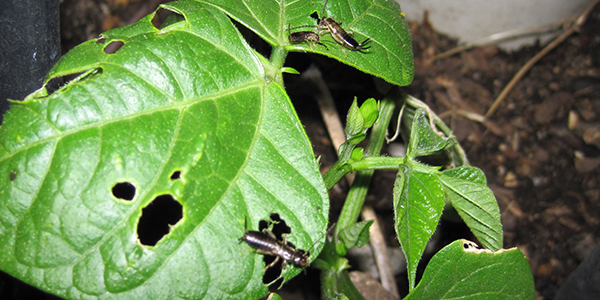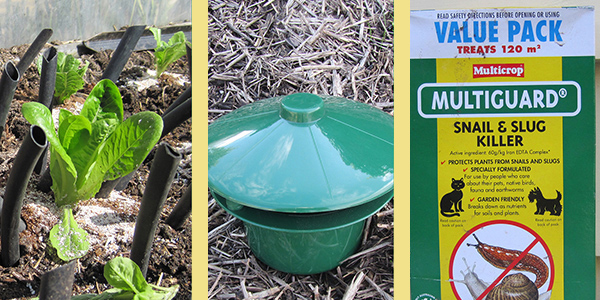If earwig numbers build up enough they can cause considerable damage to your vegetables. Here are some methods I have used to keep earwig numbers down to a manageable level without having to resort to chemical pesticides.
While there several different varieties of earwigs the one that gardeners are most likely to find in their garden is the Common or European earwig. While they can damage vegetables and flowers they are also efficient killers of small insects such as aphids. So, it is important to apply The Percentage Factor principle and only actively kill them when their numbers are high enough to cause serious damage to your plants. Having some around is beneficial to your garden.
An effective method of reducing earwig numbers quickly is to go out at night with a torch and remove them by hand. While harder to pick up than slugs and snails earwigs tend to freeze when caught in the beam of a torch. With a bit of practice it is possible to pick them up in quick succession and either squash them or put them in a container for feeding to your chickens the next day.
Though note that the larger earwigs can give you a bit of a nip with their rear pincers if you are not careful.
I discovered this method by accident when I began using 13 mm polypipe stakes to deter blackbirds from scratching up my vegetable beds. I noticed that earwigs were hiding in these hollow tubes during the day and emerging at night to feed. I quickly realised they offered ready traps for catching and destroying earwigs. For more information about using polypipe stakes to deter birds see DETER: Birds/POLYPIPE PHALANX STAKES.
- DRIVE POLYPIPE STAKES INTO THE GROUND AS PER THE PHALANX STAKES METHOD USED TO DETER BIRDS
This can be done at any time but it is a useful thing to do when planting out seedlings as a protection against black birds. - REGULARLY LIFT THE STAKES AND TAP THE ENDS INTO A BOWL TO DISLODGE ANY EARWIGS HIDING IN THEM
To dispose of the earwigs drown them in water, crush them or feed them to your chickens if you have any. - REPEAT THIS PROCESS WHEN THE CROP IS BEING PULLED OUT
If the earwigs are only doing minor damage then this process of dislodging the earwigs from the polypipe stakes need only be done when the crop is being pulled as a way of keeping earwig numbers down.

Earwigs will hide inside the polypipe stake tubes (LEFT) during the day and come out at night to feed (RIGHT).

Polypipe tubes around newly planted lettuce seedlings. The tubes are primarily there to stop blackbirds scratching up the seedlings, but they also act as effective earwig traps.
If you don’t need to use Polypipe Phalanx Stakes to stop birds scratching up your beds then an alternative is to lay horizontal lengths of 13mm polypipe in your bed, pulling them up to dispose of the earwigs hiding inside as you would for the polypipe phalanx stakes. An alternative to polypipe is to cut up lengths of an old garden hose.
There are two types of earwig paper traps. Both of which I have found to be effective, but these days I prefer to use the Polypipe tube traps described above as they involve less work.
- SCRUNCH-UP SHEETS OF WET NEWSPAPER AND PLACE IN SMALL POTS OR PLASTIC CONTAINERS.
- TURN THE POST UPSIDE DOWN AND PLACE IN YOUR GARDEN WHERE EARWIGS HAVE BEEN ACTIVE
The scrunched up paper offers good cover for earwigs to hide in during the day. - AFTER SEVERAL DAYS REMOVE THE PAPER AND SUBMERGE IT IN WATER
If there are any earwigs inside they will come to the surface.
- LOOSELY ROLL UP SOME SHEETS OF NEWSPAPER AND SECURE EACH END WITH RUBBER BANDS
- PLACE IN YOUR GARDEN WHERE EARWIGS HAVE BEEN ACTIVE
The gaps between the sheets of paper offer good cover for earwigs to hide in during the day. - AFTER SEVERAL DAYS REMOVE THE ROLL AND SUBMERGE IT IN WATER
If there are any earwigs inside they will come to the surface. You can also burn the roll or throw it in the rubbish bin.

LEFT: Scrunched-up newspaper earwig traps. RIGHT: Rolled up newspaper earwig trap.
The smell of the soy sauce attracts the earwigs and the oil traps and eventually drowns them in a sort of mini La Brea Tar Pit.
- FILL A SHALLOW OPEN CONTAINER WITH COOKING OIL AND ADD A SPLASH OF SOY SAUCE
Sardine cans are ideal, though any shallow container will do. - PLACE THE CONTAINER WHERE EARWIGS HAVE BEEN ACTIVE AND COVER WITH A SLIGHTLY LARGER WATERPROOF CONTAINER
The larger container is to prevent rainwater diluting the oil mixture. - AFTER A COUPLE OF WEEKS REPLACE WITH FRESH OIL AND SOY SAUCE.

LEFT: Soy sauce and oil earwig trap amongst carrots. RIGHT: Detail of a Soy sauce and oil earwig trap made from a sardine can.




